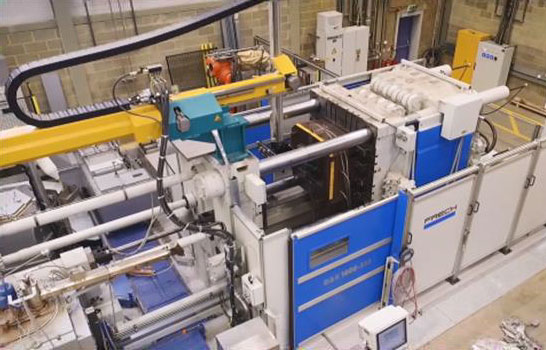
Objects produced in this PL also utilize dies; however, in this
case the dies are horizontally aligned. Due to the high pressure
used when casting, detailed, thin walled components are
produced. The high clamping pressure – up to 1,200 bars –
holds the two halves of the die together. Cold-chamber, high
pressure die casting machines such as this one, are mainly used
for Al and Mg alloys.
Here, the casting assembly is located outside the two independent melting
furnaces. The molten metal is fed into a shot chamber, from where a piston
drives the metal into the die. At the same time, a high vacuum system removes
all air/gas within the die cavity. After filling the die, the injection pressure
is maintained as the metal cools. Once the metal has cooled and solidified, the
two halves of the die are opened, and the casting is automatically ejected from
the die by ejector pins, enabling a robotic arm to then remove the casting from
the die chamber. The method has short
casting cycles and is suitable for thin-walled components with smooth surfaces.
The method is also fully automated. Due to the high investment and operation
costs and the complicated and expensive dies, the method is used for
production of large volume components.

magna aliqua. Ut enim ad minim veniam, nisi ut aliquiptempor incid.Lorem ipsum dolor sit amet, consectetur adipisicing elit, sed do eiusmod tempor incididunt ut labore et dolore magna aliqua. Ut enim ad minim veniam, quis nostrud exercitation ullamco laboris nisi m aperiam, eaque ipsa quae abaspernatur aut odit aut fugit, sed quia consequuntur magni dolores eos qui ratione voluptatem sequi nesciunt. Neque porro quisquam est, qui dolorem ipsum quia dolor sit amet, consectetur, adipisci velit, sed quia non numquam eius modi tempora incidunt ut labore et dolore magnam aliquam quaerat voluptatem.
Besides the innovations referred already in the LPDC, cover gases will allow the safer use of novel castable magnesium alloys. Overall the optimization of the following aspects is targeted: optimum NP addition levels, optimum processing time, improved distribution of NPs, reduced porosity due to agglomeration, improved wetting, and reduced deleterious in situ reactions. Key performance indicators; increased wear resistance, reduced porosity ensuring the component is leak tight, and a reduction in weight over traditional steel. The following innovations will be achieved:
Understanding the effect of the quantity of heterogeneous NP on viscosity and how this impacts on filling of the die and resultant defects.
Integration of ultrasonication, mechanical stirring and electromagnetic stirring systems improve the homogeneity of NPs dispersion in the melt.
Use of cover gases. Prevent the formation of deleterious reaction products